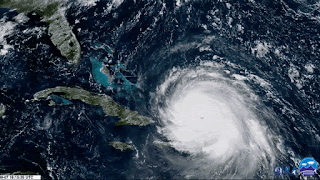An earthquake of magnitude 8.1 struck off the southern coast of Mexico late on Thursday, the U.S. Geological Survey (USGS) said, killing at least six people and triggering small tsunami waves but no major destruction.
The quake was apparently stronger than a devastating 1985 tremor that flattened swathes of Mexico City and killed thousands, but this time damage to the city was limited.8.1 is huge. The death toll is certainly going to rise:
A number of buildings suffered severe damage in parts of southern Mexico. Some of the worst initial reports came from Juchitan in Oaxaca state, where sections of the town hall, a hotel, a bar and other buildings were reduced to rubble.Meanwhile, Irma is coming:
Rescue workers labored through the night in badly affected areas to check for people trapped in collapsed buildings.
Windows also shattered at Mexico City airport and power went out in several neighborhoods of the capital, affecting more than 1 million people. The cornice of a hotel came down in the southern tourist city of Oaxaca, a witness said. The tremor was felt as far away as neighboring Guatemala.
Hurricane Irma poses the most significant threat to Florida in memory — and "this is the kind of storm that you read about in the history books," said Bryan Norcross, senior hurricane specialist at The Weather Channel.If you want a visual representation of how big Irma is, this will do the trick:
"This has the possibility of running up the peninsula and affecting every major city in the state. It's not certain that that's what's going to happen, but it certainly is a possibility," Norcross said Wednesday.
"We don't know what is going to happen exactly. But we know what the range of possibilities is — and this is a situation where the top of that range is extraordinarily extreme," he said. "This is the kind of storm that I always pictured when I read the history books about the great Florida hurricanes of the past and imagined how they would impact the modern state."
The smaller hurricane that flashes on and off in the GIF is Hurricane Andrew. Irma is the big one behind it.
And then there's the West:
Dozens of forest and brush fires are currently burning across eight western states, forcing thousands to flee, destroying homes, and closing highways. Enormous volumes of smoke and ash are being thrown into the atmosphere as more than a million acres have burned in the past week alone, creating hazardous breathing conditions in many parts of the Pacific Northwest. In California, the La Tuna fire near Burbank has burned nearly 7,200 acres, becoming the largest fire ever recorded in Los Angeles in terms of area.Here's a look at the fire in the Columbia River gorge, between Washington state and Oregon:
 |
| Burning, burning, all you can take |
And in case that wasn't enough, how about some mosquito trouble:
A mounting number of citations on a popular disease-tracking website suggests that mosquitoes may be moving into new ecological niches with greater frequency.On the bright side, it's going to be a lovely day in Minneapolis. So we got that going for us.
The website, ProMED mail, has carried more than a dozen such reports since June, all involving mosquito species known to transmit human diseases.
Most reports have concerned the United States, where, for example, Aedes aegypti — the yellow fever mosquito, which also spreads Zika, dengue and chikungunya — has been turning up in counties in California and Nevada where it had never, or only rarely, been seen.

1 comment:
I blame Chiffon margarine.
Post a Comment